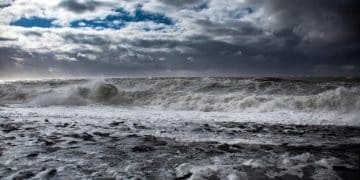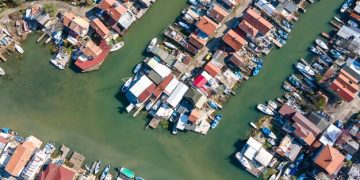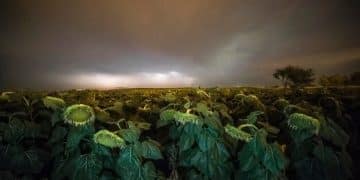Climate Change’s Role in US Southwest Droughts
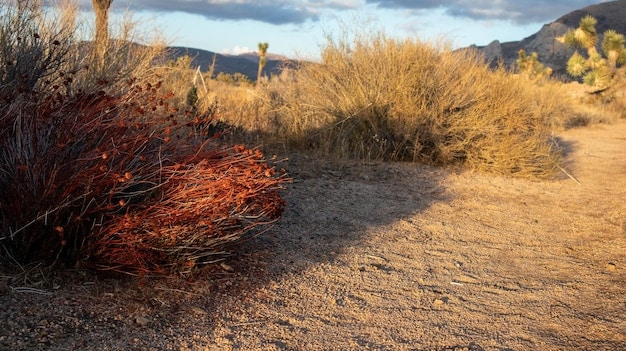
The US Southwest faces amplified drought frequency and intensity due to climate change, primarily driven by rising temperatures, altered precipitation patterns, and increased evaporative demand, exacerbating water scarcity for ecosystems and human populations.
Understanding How is Climate Change Affecting the Frequency and Intensity of Droughts in the US Southwest? is crucial. This region, already prone to aridity, finds its delicate balance increasingly disrupted by a warming planet, leading to profound and often devastating consequences for its natural systems and vital resources.
The Arid Legacy: Understanding the US Southwest’s Natural Drought Predisposition
The US Southwest, encompassing states like Arizona, New Mexico, Utah, Nevada, and parts of California and Colorado, is inherently arid. Its geography and atmospheric circulation patterns historically predispose it to extended periods of dryness. This natural vulnerability sets the stage for how climate change interacts with and amplifies existing drought conditions.
The region’s climate is largely shaped by its position within the subtropical high-pressure belt, which typically suppresses precipitation. Coupled with mountain ranges that create rain shadows, much of the landscape receives minimal annual rainfall. This natural aridity means that even small shifts in climatic variables can have disproportionately large impacts on water availability.
Historical Drought Patterns
Paleoclimatic studies, using tree rings and sediment cores, reveal a long history of severe and prolonged droughts in the Southwest, some lasting for decades or even centuries. These “megadroughts” demonstrate the region’s inherent susceptibility to natural climatic variability, often linked to phenomena like persistent La Niña conditions in the Pacific Ocean.
- Tree Ring Data: Provides a rich record of past drought severity and duration, extending back over a millennium.
- Sediment Cores: Reveal long-term patterns of lake levels and vegetation, indicating past hydrologic conditions.
- Natural Variability: Historically, natural climate oscillations have driven significant drought cycles in the region.
Understanding these pre-existing patterns is fundamental because climate change isn’t creating drought from scratch; rather, it’s overlaying new pressures onto an already water-stressed system. The Southwest has always been a land of extremes, but the anthropogenic signal of global warming is now pushing these extremes into uncharted territory, making the “new normal” vastly different from historical averages.
The intricate interplay between natural climatic drivers and human-induced warming is what makes the current drought situation so complex and concerning. While the region has evolved adaptively to a certain level of aridity, the rapid pace and unprecedented scale of current changes challenge the resilience of both natural and human systems.
Rising Temperatures: The Accelerator of Southwestern Drought
Perhaps the most direct and undeniable way climate change is fueling drought in the US Southwest is through rising ambient temperatures. Global warming, driven by greenhouse gas emissions, directly translates to hotter days and nights across the region. This isn’t just about uncomfortable heat; it has profound hydrological implications.
Increased Evaporation and Evapotranspiration
Higher temperatures directly lead to increased evaporation from water bodies, soil, and plant surfaces. This process, known as evapotranspiration when considering plant water loss, sucks moisture out of the landscape at an accelerated rate. Even if precipitation levels remained constant – which they generally haven’t – the evaporative demand alone would intensify aridity.
Imagine a sponge drying out faster under a hotter lamp. That’s essentially what’s happening across the Southwest’s vast land and water surfaces. The atmosphere’s increased capacity to hold moisture at higher temperatures paradoxically makes the land drier. This “aridification” effect is a signature of human-caused warming.
- Reservoir Levels: Lakes Mead and Powell, critical water storage for millions, are at historic lows due to reduced inflows and increased evaporation.
- Soil Moisture: Warmer temperatures deplete soil moisture more rapidly, stressing vegetation and increasing wildfire risk.
- Snowpack Loss: Higher temperatures cause snow to melt earlier in the spring, leaving less snowpack to feed rivers later in the year.
The warming trend is evident in observed data, showing a consistent and statistically significant rise in average temperatures across the Southwest over the past several decades. This trend is unequivocally linked to anthropogenic climate change, and its impacts on the water cycle are being felt with increasing intensity.
The energy balance of the Earth’s surface largely determines how much water evaporates. As more energy, in the form of heat, is trapped by greenhouse gases, more energy is available to convert liquid water into water vapor, pulling it away from critical surface and subsurface reservoirs. This fundamental physical process is a key driver of the intensified drought the Southwest is now experiencing.
Altered Precipitation Patterns: The Shifting Rains of the Desert
Beyond the direct impact of temperature, climate change is also altering the timing, intensity, and form of precipitation in the US Southwest. While the region is naturally arid, it relies on specific seasonal precipitation patterns, particularly winter snowpack and the summer monsoon, to replenish its water resources. These patterns are increasingly disrupted.
One critical change is the shift in precipitation from snow to rain, particularly at lower elevations. Warmer winters mean that less precipitation falls as snow, and what snow does accumulate melts earlier in the spring. Snowpack in the mountains acts as a natural reservoir, slowly releasing water into rivers and streams throughout the dry season. A diminished or rapidly melting snowpack means less water is available when it’s most needed.
Winter Snowpack Decline
The Colorado River Basin, a lifeline for much of the Southwest, is heavily reliant on snowmelt from the Rocky Mountains. Studies indicate a significant decline in snow water equivalent (SWE) over recent decades, a direct consequence of rising winter temperatures. This reduction in the “frozen reservoir” has profound implications for water supplies downstream.
- Reduced Runoff: Less snowpack universally translates to reduced streamflow into major rivers and reservoirs.
- Earlier Melt: Pre-season melting leads to water availability peaking too early for peak demand periods.
- Rain-on-Snow Events: Warmer temperatures can lead to rain falling on existing snowpack, accelerating melt and increasing flood risk, rather than steady water release.
The summer monsoon, another crucial precipitation source, is also showing signs of change. While highly variable by nature, there are indications of shifts in its onset, duration, and intensity. Some research suggests more extreme, but less frequent, rainfall events, which can lead to flash flooding and less effective water absorption into soils.
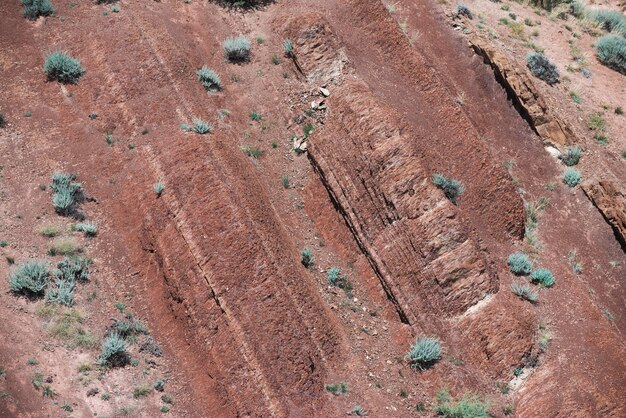
The complexity of these shifts makes water management even more challenging. Relying on historical averages for planning purposes becomes inadequate when the underlying climate system is undergoing fundamental transformations. Future water security hinges on adapting to these new precipitation realities.
The changing balance between snow and rain, coupled with altered atmospheric dynamics that steer storm systems, means that the Southwest is facing not just a quantitative decrease in effective water input, but also a qualitative change in how and when that water arrives. This redefines the hydrological landscape of the region.
Atmospheric Dynamics and Drought Persistence: The Feedback Loops
The influence of climate change on Southwestern droughts extends beyond simple temperature and precipitation metrics to complex atmospheric dynamics. Large-scale atmospheric circulation patterns, in conjunction with rising global temperatures, can create feedback loops that intensify and prolong dry conditions.
One such dynamic involves changes in the jet stream and the expansion of the Hadley Cell. The Hadley Cell is a global atmospheric circulation pattern that brings dry, subsiding air to subtropical regions, including the US Southwest. Climate models and observations suggest that this cell is expanding poleward, pushing arid conditions further north into historically less dry areas.
Persistent High-Pressure Systems
Warmer global temperatures can influence the frequency and persistence of atmospheric high-pressure ridges over the Southwest. These ridges act as atmospheric domes, deflecting storm systems away from the region and suppressing cloud formation and precipitation. When these high-pressure systems become “stuck” for extended periods, they lead to prolonged sunny, dry, and hot conditions, exacerbating drought.
- Blocking Patterns: Atmospheric mechanisms that prevent weather systems from moving, leading to prolonged extremes.
- Ridge Amplification: Climate change may be favoring stronger and more frequent ridge formations over the western US.
- Storm Track Shifts: The pathways of moisture-bearing storms are being altered, bypassing traditionally wet areas.
The interaction between these large-scale atmospheric patterns and a warming land surface creates a powerful cycle of drought intensification. A warm, dry atmosphere leads to drier soils, which in turn warm the atmosphere further (because less energy goes into evaporation), perpetuating the dry spell. This feedback mechanism helps explain the severity and persistence of recent droughts.
Furthermore, phenomena like “atmospheric rivers” – narrow bands of concentrated moisture that deliver significant precipitation to the West Coast – might also be affected. While these can bring temporary relief, their frequency, intensity, and landfalling locations could shift, potentially making water delivery less reliable and more extreme. Understanding these complex atmospheric teleconnections is vital for future drought prediction and mitigation.
Ecological and Socio-Economic Consequences of Prolonged Drought
The escalating frequency and intensity of droughts, fueled by climate change, inflict profound ecological and socio-economic consequences across the US Southwest. These impacts ripple through natural ecosystems, agricultural sectors, urban water supplies, and public health.
Impacts on Ecosystems and Biodiversity
Prolonged drought places immense stress on the region’s unique desert and specialized mountain ecosystems. Native vegetation, adapted to periodic dryness, struggles to survive extended periods without sufficient water. This leads to increased tree mortality, particularly in forests that become more susceptible to insect infestations and disease.
Wildfires, a natural part of many Western ecosystems, become more frequent, larger, and more intense during drought conditions. Drier fuels and higher temperatures create ideal conditions for rapid fire spread, leading to extensive destruction of habitats, air quality degradation, and increased risks to human communities. Biodiversity suffers as species struggle to adapt or migrate in response to rapidly changing conditions.
- Forest Die-off: Widespread mortality of trees like piñon pines and junipers due to water stress and bark beetle outbreaks.
- Reduced Habitat: Decreased water availability impacts wetlands, riparian zones, and aquatic species.
- Wildfire Risk: Exacerbated by dry vegetation, leading to catastrophic fires and long-term ecosystem damage.
For human populations, water scarcity is the most immediate and pressing concern. Agriculture, a significant user of water in the Southwest, faces severe restrictions, leading to crop failures, reduced yields, and economic losses for farmers. Urban areas, despite significant conservation efforts, face threats to their long-term water security, prompting difficult decisions about water allocation and growth.
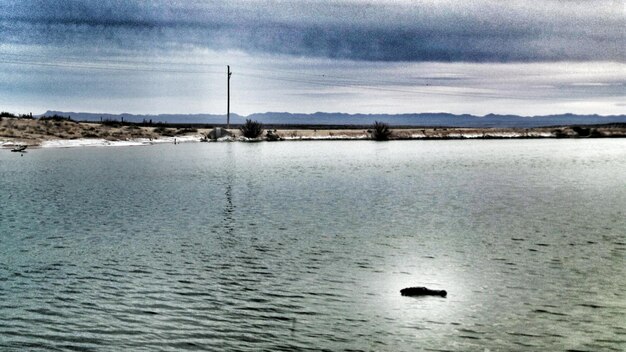
Hydropower generation, a critical source of renewable energy for the region, is also impacted as water levels in major reservoirs like Lake Mead and Lake Powell drop, reducing their capacity to generate electricity. This necessitates reliance on other, often more carbon-intensive, energy sources, creating a challenging feedback loop.
Public health is affected through poorer air quality from wildfires, increased heat-related illnesses during extreme heat waves, and potential impacts on drinking water quality as water sources become more concentrated or contaminated. The confluence of these factors paints a challenging picture for the future of the Southwest under continuing climate change.
Water Management and Adaptation Strategies in a Drying Future
Given the intensifying drought conditions driven by climate change, effective water management and robust adaptation strategies are paramount for the US Southwest. The traditional approaches to water allocation, largely based on outdated precipitation norms, are no longer sufficient to sustain the region’s growing population and ecological needs.
One critical area of focus is demand management and conservation. Urban centers have made significant strides in reducing per capita water use through technological advancements and behavioral changes. Xeriscaping, efficient irrigation systems, and public awareness campaigns play a vital role. However, further reductions are often necessary, especially in the agricultural sector, which accounts for the largest share of water consumption.
Innovative Water Solutions
Beyond conservation, communities and water authorities are exploring and implementing innovative solutions to augment water supplies or make existing supplies more resilient. These include:
- Water Recycling and Reuse: Treating wastewater to a high standard for non-potable or even potable applications.
- Stormwater Capture: Collecting and infiltrating urban runoff to replenish groundwater or for direct use.
- Desalination: While energy-intensive, coastal communities are exploring ocean desalination as a potential, albeit costly, future water source.
- Conjunctive Use of Water Sources: Strategically blending and managing surface water and groundwater resources to optimize availability.
Interstate and international cooperation, particularly along the Colorado River, is essential. Historic water compacts are being re-evaluated to reflect the realities of a drier future, leading to agreements on shared cuts and collaborative conservation efforts. These negotiations are complex but vital for regional stability.
Investment in infrastructure, such as pipelines to move water more efficiently, and natural infrastructure, such as forest health initiatives that enhance watershed function, are also part of the broader strategy. Preparing for a future with less water means a multifaceted approach, combining technological innovation with policy reform and shifts in societal water habits.
Crucially, adaptation must also involve embracing a more holistic understanding of water: as an interconnected system involving rivers, groundwater, ecosystems, and human uses. Strategies that benefit one aspect shouldn’t inadvertently harm another, emphasizing the need for integrated water resource planning that considers the long-term impacts of climate change.
Future Projections and The Path Forward for the Southwest
Looking ahead, climate models consistently project a continuing trend of warmer temperatures and increased evaporative demand for the US Southwest, leading to a higher likelihood of more frequent, intense, and prolonged droughts. While precipitation projections are more variable, the overriding signal is one of greater aridity, placing unprecedented stress on the region’s water resources.
These projections underscore the urgency of aggressive climate action, both globally to reduce greenhouse gas emissions and regionally to enhance resilience. The concept of “aridification” – a long-term shift towards a drier climate – rather than just temporary drought, is gaining traction among scientists. This implies that the current water challenges are not merely a cycle to endure, but a fundamental shift requiring permanent adjustments.
Responding to a New Climate Reality
The path forward for the Southwest involves a two-pronged strategy: mitigation and adaptation. Mitigation means reducing the emissions that drive climate change, a global effort that the US, including the Southwest, must champion. Adaptation involves adjusting to the changes that are already locked in and those yet to come.
- Investment in Research: Continued scientific study to refine climate models and improve drought forecasting.
- Inter-state and Local Collaboration: Strengthening partnerships among states, tribes, and local communities for water sharing and conservation.
- Sustainable Land Use Planning: Integrating water availability into urban and agricultural development decisions.
- Public Engagement: Educating and empowering residents to adopt water-saving habits and support crucial policy changes.
The scale of the challenge requires not just incremental changes but transformative shifts in how water is valued, managed, and consumed. This includes embracing a future where water is not only conserved but where every drop is optimized for multiple uses, and natural water systems are restored and protected. The resilience of the Southwest will depend on its capacity for innovation and cooperation.
Ultimately, the region’s future success will be measured by its ability to navigate increasing water scarcity while preserving its vibrant economy and diverse ecosystems. This demands proactive governance, scientific foresight, and a collective commitment from all stakeholders to adapt to a new, drier climate reality, ensuring a sustainable future for successive generations.
| Key Point | Brief Description |
|---|---|
| 🌡️ Rising Temperatures | Increased heat accelerates evaporation and evapotranspiration, rapidly drying out soils and water bodies. |
| 🌧️ Altered Precipitation | Warmer winters reduce snowpack and cause earlier melt, impacting river flows and water supply. |
| 💨 Atmospheric Shifts | Climate change influences large-scale weather patterns, leading to persistent high-pressure systems that block rainfall. |
| 🌍 Ecological Impacts | Drought exacerbates wildfires, stresses ecosystems, impacts biodiversity, and reduces water for agriculture and urban use. |
Frequently Asked Questions About US Southwest Droughts
▼
The primary driver is rising temperatures due to climate change. These higher temperatures increase evaporation from water bodies and soil, and boost evapotranspiration from plants, effectively drying out the landscape more quickly and intensely, even if precipitation remains constant or slightly varies. This heightened evaporative demand is a direct consequence of global warming.
▼
A significant portion of the Southwest’s water supply comes from mountain snowpack that melts slowly into rivers. Reduced snowpack, caused by warmer winter temperatures (less snow, earlier melt), means less water is stored and available as runoff later in the dry season. This directly contributes to lower river flows and reservoir levels, intensifying drought conditions.
▼
Natural drought cycles, driven by phenomena like La Niña, still occur. However, human-caused climate change is now superimposing additional pressures on these natural cycles. This means that when a natural drought occurs, the additional warming makes it more severe and prolonged than it would have been historically, effectively pushing the region into unprecedented drier conditions.
▼
The societal impacts are far-reaching. They include severe water restrictions for agriculture, leading to economic losses and food security concerns. Urban areas face water supply challenges, potentially requiring rationing. Hydropower generation is reduced, and increased wildfire frequency and intensity threaten communities, infrastructure, and air quality and public health.
▼
Adaptation strategies include aggressive water conservation measures in urban and agricultural sectors, investing in water recycling and reuse technologies, enhancing stormwater capture, and exploring desalination where feasible. Interstate cooperation on water sharing agreements, like those for the Colorado River, and sustainable land use planning are also critical for long-term resilience against recurring drought.
Conclusion
The intersection of inherent aridity and accelerating climate change has unequivocally intensified the frequency and severity of droughts across the US Southwest. Rising temperatures and altered precipitation patterns are not merely amplifying natural variability; they are fundamentally reshaping the region’s hydrological landscape, ushering in an era of unprecedented water scarcity. Addressing this challenge requires a multi-faceted approach, combining robust mitigation efforts to curb global warming with innovative adaptation and water management strategies. The future of the Southwest’s ecosystems, economies, and communities hinges on its capacity to adapt to this new, drier reality with urgency and collaborative action.
